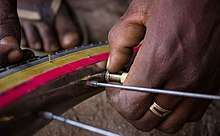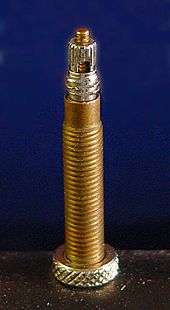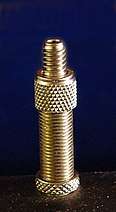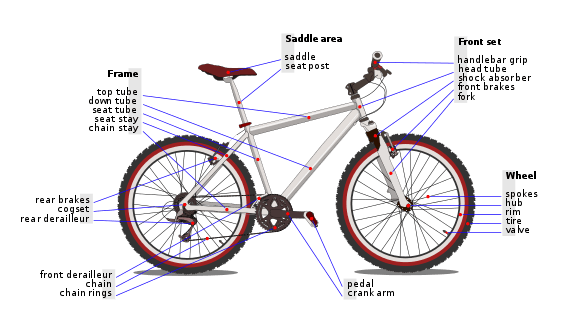Valve stem
A valve stem is a self-contained valve which opens to admit gas to a chamber (such as air to inflate a tire), and is then automatically closed and kept sealed by the pressure in the chamber, or a spring, or both, to prevent the gas from escaping. They are most commonly used on automobile, motorcycle, and bicycle tires, but also for many other applications.

Schrader

Schrader valves consist of a valve stem into which a poppet valve is threaded with a spring attached. They are used on virtually all automobile and motorbike tires, and on wider rimmed bicycle tires. In addition to tires, Schrader valves of varying diameters are used in refrigeration and air conditioning systems, plumbing, engine fuel injection, suspension systems, and SCUBA regulators, allowing the user to remove and attach a hose while in use. The Schrader valves in the fuel injector rail of many automobiles is used as a quick and easy point to check fuel pressure or connect an injector cleaner cartridge.[1]
Presta

Presta valves (also called Sclaverand valves or French valves) are normally only used on bicycles. The stem has a narrower diameter (nominally 6 mm) than the thinnest (nominally 8 mm) Schrader type, and so the bore of the hole in the rim through which the stem passes can be smaller. Has a locknut that needs to be opened to inflate/deflate.[2]
Dunlop (or Woods)

Dunlop valves, (also called Woods valves or English valves) were once popular in Great Britain. They are still widely used on bicycle tires in many countries,[3] especially on low to medium priced bicycles. They can be pumped up with a Presta pump.[4]
Others

Many other valves exist that are used only in certain regions or for limited purposes.
For example, the "Regina Valve" is a valve very much similar to the Presta and mostly being used in Italy. Invisible tire valves are different in design from traditional tire valves. An inflator stem is not used; instead, a removable cap on a valve stem embedded in the tire rim is fitted, with only the cap visible. When inflating the tire, the cap is first removed, typically with a coin, and then a "portable" dedicated inflator stem is screwed onto the valve stem. Through the inflator the tire is inflated as usual.
References
- Eugene A. Sloane (1991). Sloane's Complete Book of All-terrain Bicycles. Simon and Schuster. pp. 313–. ISBN 978-0-671-67587-5.
- Christopher Wiggins (5 June 2014). Bike Repair and Maintenance. DK Publishing. pp. 16–. ISBN 978-1-61564-511-4.
- "Japan Cycling Navigator:Information: Bikes in Japan: Tyres and Tubes". www.japancycling.org. Retrieved 2009-06-01.
- Sheldon Brown's Bicycle Glossary
External links
- summary of bicycle valve types by Sheldon Brown
- common types of valves used for bicycles
- advantages Of tire monitoring valve cap
